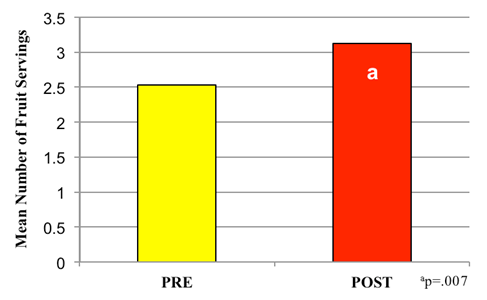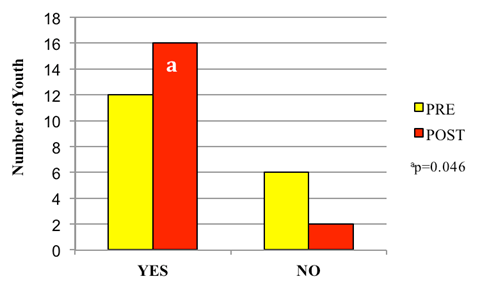 |
April 2015
|
April 2015 // Volume 53 // Number 2 // Tools of the Trade // v53-2tt8
Sequential Online Wellness Programming Is an Effective Strategy to Promote Behavior Change
Abstract
The growing number of United States youth and adults categorized as overweight or obese illustrates a need for research-based family wellness interventions. Sequential, online, Extension-delivered family wellness interventions offer a time- and cost-effective approach for both participants and Extension educators. The 6-week, online Healthy Families Challenge (HFC) resulted in increased daily fruit and vegetable servings and leisure-time physical activity. These findings suggest that an Extension-delivered, sequential, online family wellness program is an effective education strategy.
Introduction
The increasing prevalence of overweight and obesity among U.S. adults and youth is of particular concern today. Family lifestyle factors such as physical inactivity and unhealthy eating habits (e.g., energy-rich, nutrient-poor foods) are placing individuals at a greater risk of becoming overweight or obese. It is important that families be provided with research-based information and practical lifestyle recommendations so that they can begin taking small steps towards a healthier lifestyle. Sequential educational wellness programming is one approach by which families can receive targeted, credible health information. Participation barriers for traditional, face-to-face family wellness programs include both time and location of the program, while enablers include family involvement and incorporation of an online component (Smith, Staker, McManus, & Fenner, 2014). Given these aforementioned barriers in combination with limited budgets, cost-effective family wellness intervention options are needed.
Extension is well positioned to fill this void in programming. Extension-delivered, sequential, online family wellness programming may be one strategy to overcome participation barriers of prospective participants as well as the budgetary constraints often experienced by Extension educators. Extension-delivered, one-time online nutrition and food safety programs have been shown to be effective at increasing awareness of recommended nutrition practices and self-reported knowledge (Francis, Martin, & Taylor, 2012; Francis, 2014). Similarly, Campbell, Koszewski, and Behrends (2013) reported that sequential distance education, either via mail or online, was effective at producing behavior change, improved dietary intakes and enhanced self-efficacy. However, there is limited information about the effectiveness of Extension-delivered, sequential, online-only family wellness interventions in relation to behavior change.
Iowa State University's Human Sciences Extension collaborates with the statewide online wellness initiative, Live Healthy Iowa (LHI), formerly Lighten Up Iowa (Litchfield, Muldoon, Welk, Hallihan, & Lane, 2005). Live Healthy Iowa brings families, friends, businesses and communities together by offering low-cost, team-based challenges promoting healthy lifestyle changes. These challenges include:
- 10-Week Wellness Challenge (January – April)
- Strut Your Pup (April – May)
- Burst Your Thirst (June – July)
- The Next Step (September – October)
- Healthy Families (September – November)
Over 230,000 Iowans are reached through LHI via indirect, online health promotion strategies (e.g., website-based tracking system, weekly email messages, etc.). Traditionally, LHI challenges do not include online educational modules; instead, participants are sent weekly nutrition, physical activity, and motivational tips and were encouraged to seek wellness information on their own.
Description of the Healthy Families Challenge (HFC)
The HFC is a 6-week challenge for families with youth in grades K-5 that:
- Promotes family fruit and vegetable consumption
- Encourages more family physical activity participation
In 2013, the HFC was revised to include six Extension-developed, weekly online modules with accompanying materials (Table 1). The modules were developed using PowerPoint and voice recordings using Adobe software. Families who completed the six weekly challenges received a $5 gift card and were entered in a random drawing to win a $100 gift card to an Iowa resort.
| Online modules | Contents |
| Narrated, weekly nutrition and physical activity PowerPoint lessons |
|
| Weekly module topics |
|
| Team toolkit |
|
| Weekly motivational e-mails |
|
| Supplemental, online materials |
|
Methods
Families were recruited via The Healthy Iowan (a monthly e-newsletter distributed to past LHI program participants), promotional email blasts, the LHI website, and social media (i.e., Facebook and Twitter). Online registration was completed by one registrant (e.g., father, mother, guardian, etc.) via the LHI website. The family registrant completed a pre- and post-questionnaire comprised of questions from validated surveys containing questions related to:
- Fruit and Vegetable Consumption: measured with the "Fruit and Vegetable Checklist" (7 questions; Sylva, Townsend, Martin, & Metz, 2006)
- Physical Activity: assessed with two questions from the "Family Nutrition and Physical Activity Survey" pertaining to youth and family physical activity participation (Academy of Nutrition and Dietetics Foundation & Iowa State University, 2009)
Data were analyzed using IBM Statistical Package for Social Sciences for Windows (version 20.0). Only family registrants who completed both the pre- and post-questionnaires were included in the program evaluation (n=20), and only questions with both a pre- and post-response were assessed (i.e., family fruit and vegetable consumption, youth participation in leisure-time physical activity).
Sociodemographic data were analyzed using descriptive statistics. Paired samples t-test assessed pre- to post-changes in mean family-reported daily fruit servings. Wilcoxon-signed ranks tests measured pre- to post-changes in youth participation in leisure-time physical activity and family-reported consumption of 1+ vegetable servings daily. Statistical significance was determined at p≤0.05.
Findings
Sixty-one families joined the HFC. Family registrants were primarily educated, white, females age 31-40 years residing in a non-metro Iowa county (Table 2).
| Characteristic | Number | Percent (%) | |
| Agea | |||
| 18-30 years | 3 | 4.9 | |
| 31-40 years | 35 | 57.4 | |
| 41-50 years | 13 | 21.3 | |
| 51-65 years | 7 | 11.5 | |
| Genderb | |||
| Male | 6 | 9.8 | |
| Female | 54 | 88.5 | |
| Educationb | |||
| High School Graduate or GED | 2 | 3.3 | |
| Some College, No Degree | 10 | 16.4 | |
| Associate's Degree | 7 | 11.5 | |
| Bachelor's or Higher | 41 | 67.2 | |
| Ethnicityc | |||
| White | 55 | 90.2 | |
| Black | 1 | 1.6 | |
| Hispanic | 1 | 1.6 | |
| Countyd | |||
| Metro | 36 | 59 | |
| Non-metro | 36 | 59 | |
|
aN=58 participants, 3 participants did not answer; bN=60 participants, 1 participant did not answer; cN=57 participants, 4 participants did not answer; dBased on the Economic Research Service classifications (ERS, 2014). |
|||
Mean family-reported daily fruit servings significantly increased from pre (2.53 servings) to post (3.13 servings) (Figure 1).
Figure 1.
Mean Family-Reported Daily Fruit Servings

Additionally, the number of families reporting eating 1+ vegetable servings daily significantly increased from pre (n=5, 25%) to post (n=11, 55%) (Figure 2).
Figure 2.
Family-Reported 1+ Vegetable Servings Daily

The number of families reporting youth participation in leisure-time physical activity significantly increased from pre (n=12, 60%) to post (n=16, 80%) (Figure 3).
Figure 3.
Youth Participation in Leisure-Time Physical Activity

Summary
These findings suggest that an Extension-delivered, sequential, online family wellness program is effective at producing positive behavior change. The sequential online education format is an effective, low-cost, and time-saving method of promoting research-based wellness programming.
When developing Extension-delivered, sequential online programs, the following will likely contribute toward overall effectiveness:
- Use of targeted, audience-specific educational messages
- Inclusion of accompanying materials and activities that reinforce the weekly module message
- Partnering with a local organization with broader reach and resources to target an audience that may not otherwise participate in Extension programming
- Utilization of social media outlets to promote social support and idea sharing among participants
References
Campbell, C., Koszewski, W. M. & Behrends, D. (2013). The effectiveness of distance education, using blended method of delivery for limited-resource audiences in the nutrition education program. Journal of Extension [On-line], 51(4) Article 4FEA4. Available at: http://www.joe.org/joe/2013august/a4.php
Economic Research Service. (2014). Iowa: Rural definitions. Retrieved from: http://www.ers.usda.gov/datafiles/Rural_Definitions/StateLevel_Maps/IA.pdf.
Francis, S. L. (2014). Hybrid food preservation program improves food preservation and food safety knowledge. Journal of Extension [On-line], 52(4) Article 4TOT8. Available at: http://www.joe.org/joe/2014august/tt8.php
Francis, S .L., Martin, P., & Taylor, K. Consumer-centered Extension education website increases usage. Journal of Extension [On-line], 50(5) Article 5TOT2. Available at: http://www.joe.org/joe/2012october/tt2.php
Litchfield, R., Muldoon, J., Welk, G., Hallihan, J., & Lane, T. (2005). Lighten up Iowa: An interdisciplinary, collaborative health promotion campaign. Journal of Extension [On-line], 43(2) Article 2FEA6. Available at: http://www.joe.org/joe/2005april/a6.php
Smith, K. L., Staker, L. M., McManus, A., & Fenner, A. A. (2014). Barriers and enablers for participation in healthy lifestyle programs by adolescents who are overweight: a qualitative study of the opinions of adolescents, their parents and community stakeholders. BMC Pediatrics. Retrieved from: http://www.biomedcentral.com/1471-2431/14/53
Sylva, K., Townsend, M. S., Martin, A., & Metz, D. (2006). Food stamp program fruit and vegetable checklist. Retrieved from: http://ucanr.edu/sites/CEprogramevaluation/files/113711.pdf.
The Academy of Nutrition and Dietetics Foundation and Iowa State University. (2009). Family nutrition and physical activity screening tool. Retrieved from http://www.adaf. eatright-fnpa.org/public/partner.cfm.



